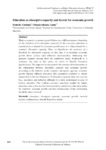Education as absorptive capacity and its role for economic growth

Use this link to cite
http://hdl.handle.net/2183/35831Collections
- Investigación (FEE) [923]
Metadata
Show full item recordTitle
Education as absorptive capacity and its role for economic growthDate
2017Citation
Mourelle, E.; Márquez-Ramos, L. (2017): Education as absorptive capacity and its role for economic growth, 3rd International Conference on Higher Education Advances, HEAd’17 (Universitat Politècnica de València, 2017) – Proceedings of the 3rd International Conference on Higher Education Advances, pp. 844-853, DOI: http://dx.doi.org/10.4995/HEAd17.2017.5440
Abstract
[Abstract]: Might a country’s economic growth behave in a different manner depending
on the evolution of its absorptive capacity? In this research, education is
considered as a channel for economic growth since it is a key element for a
country’s absorptive capacity. Then, we hypothesize the existence of a
threshold for absorptive capacity, so that once it is exceeded, economic
growth shows certain (and different) characteristics. Addressing this
question requires moving from the traditional linear framework to a
nonlinear one and, in this sense, we resort to Smooth Transition
specifications. The empirical results point to the existence of nonlinearities in
the relationship between absorptive capacity and economic growth.
According to the behavior of the country’s absorptive capacity, economic
growth displays different dynamics; this asymmetric evolution is clearly
appreciated in the two dimensions of absorptive capacity taken into account
(i.e., secondary and tertiary), although it is more pronounced in case of
tertiary education. Our evidence provides important insights for higher
education such as the fact that both secondary and tertiary education matter
for countries’ economic growth and that nonlinearities of this relationship
should be taken on board.
Keywords
Education
Absorptive capacity
Economic growth
Network society
Nonlinearities
Smooth Transition models
Absorptive capacity
Economic growth
Network society
Nonlinearities
Smooth Transition models





